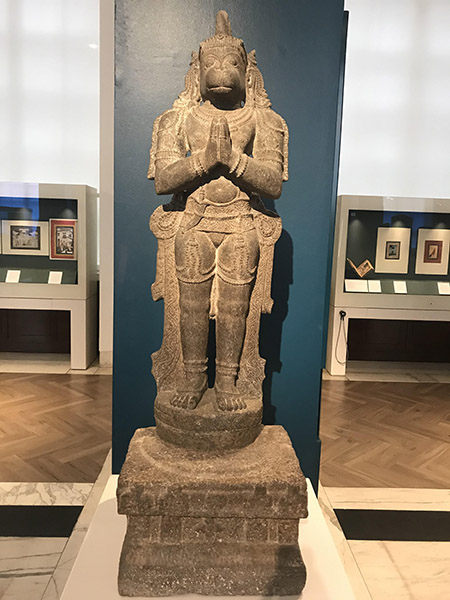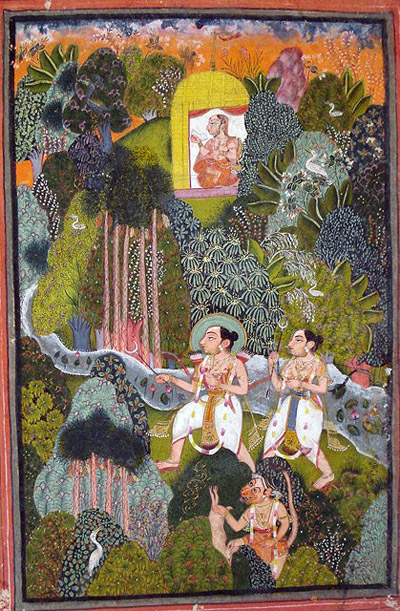The Ramayana is one of South Asia's oldest epic poems. The work--transmitted and transformed orally for centuries before being written down sometime in the fourth century BCE--is a mix of politics, history, myth, religion and adventure that tells the story of Rama, Sita and Hanuman. The poem also very much resembles Homer's The Odyssey and Iliad in its structure and form; but unlike Homer's work, the Ramayana has continued to undergo transformation and further development since its origin. The version used in this course is by R. K. Narayan and based on an eleventh-century Tamil edition of the epic.
The Ramayana is often called the "adikavya" (first poem) and Valmiki--the "adikavi" (first poet). Valmiki, the traditional author of the poem, lived maybe 1000 BCE, although versions of the long epic poem pre-date Valmiki. The final version can be roughly dated to early forms of the Mahabharata. According to Hindu tradition, Rama is an incarnation (avatar) of the God Vishnu. The main purpose of this incarnation is to demonstrate the righteous path (dharma) for all living creatures on earth.
The Ramayana is the shorter of the two great epic poems of India, the other being the Mahabharata. (If you take Professor Nayak's mythology course, you get to read the Mahabharata). The Ramayana, in Sanskrit, consists of some 24,000 couplets divided into seven books. The epic focuses on the birth, youth and adventures of Rama. Most of the characters, including Rama, Sita, Hanuman, etc are incarnations of the Hindu gods. If you thought Greek mythology was complicated, this is far more interesting!
The Ramayana, as one of the two major Hindu myths of Ancient India, played an important role in giving meaning to the people's life. Myth, as an essential element of a society, served to explain one's place in the world and how the world worked. Myth made the world less mysterious and the unknowable--knowable. For some excellent background on the functions/theory of myth, see Joseph Campbell's four functions of myth.
Fun fact about the Ramayana
According to legend, the poet who wrote the Ramayana was originally a thief. One day he tried to rob a sadhu, who of course owned nothing. The sadhu gave him a mantra: "Mara" (evil). Valmiki liked it and kept repeating it, and he gradually became a better person. Then he realized that when he was saying "mara mara mara" he was also saying "rama rama rama." He then wrote the Ramayana in honor of the god who had changed his life.
Some more fun facts
The Ramayana is extremely popular. India nearly shut down when a dramatized series of the Ramayana appeared on television in the 1980s. Recitation of the Ramayana earns great merit....Gandhi called it the greatest book in the world. Tulsi Das, medieval author of the Hindi translation, said, "Whenever I remember Rama's name, the desert of my heart blooms lush and green."
While it is difficult to make any specific historical connections to the story of the Ramayana, take a moment and read about Rama's bridge.
Some notes on Hindu mythology (used with the permission of Professor Meena Nayak)
- Gods are anthropomorphic, but their human traits are only visible when they are in the form of humans, which they take to combat the dark forces, like Krishna (an incarnation of Vishnu, the Preserver) does in The Mahabharata.
- Gods are immortal BUT NOT Eternal. They die at the end of the four eons which make up a Hindu universe. (You will learn more about this in the Introduction to Hindu Mythology).
- They, like Greek gods, interfere in human matters, and sometimes for selfish reasons.
- Also similar to Greek gods, they too can be kept happy with rituals. However, the temples are built not so much to honor them but as a way for people to remember their existence. Unlike in Greek society, temples are not all important in Hindu society.
- The Hindu equivalent to honor & glory is the practice of Dharma, which is really a sustenance of social order through right action. (Also see explanation of Dharma and Karma above). Dharma brings honor & glory and that brings men closer to the gods.
- Another way of communicating with the gods is sacrificing one's self, body and soul to a god and gaining that god's good will and boons. The Hindu term for this concept is bhakti.
- Above the gods, there is a supreme being, who rules and will always rule, even at the end of the four ages (kalpas, each one is 4,320,000,000 years), after which the universe will be annihilated and that One Supreme Being (Brahman--different from the Creator god, Brahma) will create a new Universe again.
- Some lesser gods are only different manifestations of qualities, elements of nature, etc. However, the main gods, such as Shiva and Vishnu, are complete and three dimensional.
- Destiny or rather TIME is supreme. Even the gods do not have rule over that.
- BUT humans through the theory of Karma (the law of cause & effect) can in a way preordain their destiny. So in some ways humans have the power to become more powerful than the gods.
- Everything is recycled. Nothing dies. Hindus believe in the reincarnation of the soul. The gods do not and cannot interfere in their births and rebirth. These are determined by man's own Dharma and Karma.

Hanuman, statue, 1600s, British Museum; photo credit Kyra Schumacher.
![]()
Some recommended online lectures, websites and versions/translations of the epic
- The two Wikipedia entires on the Ramayana and Valmiki are good starting points.
- Word to Word Translation of the Valmiki Ramayana with Sanskrit text and audio
- Another site with the Valmiki Ramayana Text and explanation
- Ralph T. A Griffith, Ramayana of Valmiki (1870-74)
- Religious Texts of India, Ramayana
- Lord Rama - The Ideal Avatar
- The Two Great Epics [of India]
- "Hindu epic Ramayana reborn with modern touch" is about the new illustrated version of the epic published by Pixar animator Sanjay Patel, Ramayana: Divine Loophole
- Cliff Notes about Indian mythology
- Indian Divinity
- Rama and the Ramayana: Crash Course World Mythology #27
- Indian Mythology: Stories, Tales and Legends
- Hindu Mythology, Vedic and Puranic by W. J. Wilkins (1900)
- For extra credit please suggest to your instructor a relevant website for this unit of the course. Send the title of the site, the URL and a brief explanation why you find the information interesting and applicable to the material being studied in this unit.
